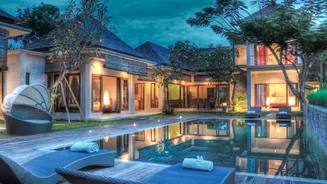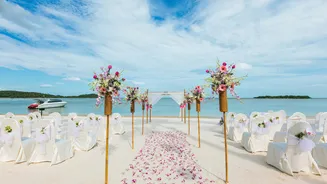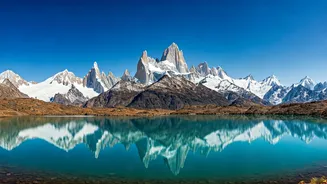What is the story about?
The discussion around luxury vacation homes in India spans both lifestyle and financial planning considerations. While developers point to continued buyer interest in select destinations such as Goa and Alibaug, the decision to purchase a second home remains influenced by individual priorities, long-term affordability, and property management options.
Balancing use and investment
Industry executives say that second homes must be evaluated both for personal use and as real estate assets that may generate income or appreciate over time.
Arjun Malhotra, Vice President – Business Growth & Strategy at The Chapter, said, “Affluent Indians today see luxury second homes as more than just a property. They are extensions of their lifestyle and expressions of aspiration, while also serving as strategic investments.”
He added, “Buying a luxury second home is no longer simply a transactional decision. It is a journey where every space reflects the owner’s tastes, priorities, and lifestyle aspirations.”
Citing an industry luxury residential survey, Malhotra noted that 54% of respondents were looking to buy or upgrade their second home, which “signals that this is not a passing trend, but a structural evolution in how buyers view premium properties.”
Malhotra said that in this category, design and long-term value go hand in hand. “Homes today are envisioned as sanctuaries that offer hybrid living, wellness, and leisure — where family, friends, and personal passions converge.”
Costs, taxation, and compliance
From a financial perspective, experts highlight that second-home ownership involves recurring expenses and regulatory obligations.
Saurabh Vohara, Founder and CEO of ALYF, recommended allocating around 1–2% of the property’s value annually for maintenance, along with factoring in tax on rental income, which falls under the “Income from House Property” category.
He also underlined the importance of verifying property titles and ensuring compliance with local laws, particularly when buying in another state.
According to Vohara, developers and platforms offering property management and rental operations can make ownership more transparent and predictable.
Varun Nagpal, Founder of Vianaar, said that managed stay platforms have simplified the operational aspects of second-home ownership by taking care of maintenance, guest management, and reporting.
“What matters now is working with credible management partners who maintain compliance and service quality,” he said.
Regional demand and price behaviour
Goa remains one of the most sought-after destinations for premium villas, with developers reporting steady demand from metro-based buyers and overseas Indians. Interest has gradually expanded to areas such as South Goa and inland stretches of North Goa.
According to Nagpal, locations like Alibaug, Coorg, and Karjat are also witnessing activity, aided by road connectivity and infrastructure projects such as the Navi Mumbai International Airport.
Developers say that limited supply of ready villas and land parcels has kept inventories tight, which has helped support prices in certain micro-markets.
Design priorities and market outlook
The profile of second-home buyers has changed alongside more flexible work patterns. Developers note that preferences now include larger spaces, wellness amenities, and sustainable materials.
Nagpal said that homes designed with long-term resilience — architectural and environmental — tend to hold value better over time.
While higher construction costs and borrowing rates could temper near-term affordability, most experts expect steady demand for properties that combine personal use with long-term ownership value.
Vohara said that buyer expectations are evolving, but interest remains stable in locations with strong connectivity and managed infrastructure.
The personal finance lens
Advisers view second homes as assets that require a planned approach to liquidity, taxation, and maintenance. Experts recommend evaluating such purchases in the context of one’s broader portfolio, ensuring adequate emergency and retirement buffers before committing to a high-value property.
Balancing use and investment
Industry executives say that second homes must be evaluated both for personal use and as real estate assets that may generate income or appreciate over time.
Arjun Malhotra, Vice President – Business Growth & Strategy at The Chapter, said, “Affluent Indians today see luxury second homes as more than just a property. They are extensions of their lifestyle and expressions of aspiration, while also serving as strategic investments.”
He added, “Buying a luxury second home is no longer simply a transactional decision. It is a journey where every space reflects the owner’s tastes, priorities, and lifestyle aspirations.”
Citing an industry luxury residential survey, Malhotra noted that 54% of respondents were looking to buy or upgrade their second home, which “signals that this is not a passing trend, but a structural evolution in how buyers view premium properties.”
Malhotra said that in this category, design and long-term value go hand in hand. “Homes today are envisioned as sanctuaries that offer hybrid living, wellness, and leisure — where family, friends, and personal passions converge.”
Costs, taxation, and compliance
From a financial perspective, experts highlight that second-home ownership involves recurring expenses and regulatory obligations.
Saurabh Vohara, Founder and CEO of ALYF, recommended allocating around 1–2% of the property’s value annually for maintenance, along with factoring in tax on rental income, which falls under the “Income from House Property” category.
He also underlined the importance of verifying property titles and ensuring compliance with local laws, particularly when buying in another state.
According to Vohara, developers and platforms offering property management and rental operations can make ownership more transparent and predictable.
Varun Nagpal, Founder of Vianaar, said that managed stay platforms have simplified the operational aspects of second-home ownership by taking care of maintenance, guest management, and reporting.
“What matters now is working with credible management partners who maintain compliance and service quality,” he said.
Regional demand and price behaviour
Goa remains one of the most sought-after destinations for premium villas, with developers reporting steady demand from metro-based buyers and overseas Indians. Interest has gradually expanded to areas such as South Goa and inland stretches of North Goa.
According to Nagpal, locations like Alibaug, Coorg, and Karjat are also witnessing activity, aided by road connectivity and infrastructure projects such as the Navi Mumbai International Airport.
Developers say that limited supply of ready villas and land parcels has kept inventories tight, which has helped support prices in certain micro-markets.
Design priorities and market outlook
The profile of second-home buyers has changed alongside more flexible work patterns. Developers note that preferences now include larger spaces, wellness amenities, and sustainable materials.
Nagpal said that homes designed with long-term resilience — architectural and environmental — tend to hold value better over time.
While higher construction costs and borrowing rates could temper near-term affordability, most experts expect steady demand for properties that combine personal use with long-term ownership value.
Vohara said that buyer expectations are evolving, but interest remains stable in locations with strong connectivity and managed infrastructure.
The personal finance lens
Advisers view second homes as assets that require a planned approach to liquidity, taxation, and maintenance. Experts recommend evaluating such purchases in the context of one’s broader portfolio, ensuring adequate emergency and retirement buffers before committing to a high-value property.
Do you find this article useful?

















